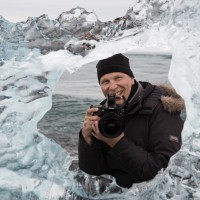At 3:00 a.m. the sky was already clear, and three hours later the airplane engine was warmed up and all equipment was packed. Takeoff was smooth, and soon I leveled off at approximately 1000 feet (300 m) above the terrain with my son in the backseat.
Weather conditions were very promising as the cold front was passing overnight, so I checked the short-term weather forecast, which promised good visibility and only weak to moderate wind up to 5000 feet (1500 m) above sea level.
In October in Slovenia, the weather usually stabilizes and extremes are not as pronounced as they are in the late summer. The window of opportunity for taking good photos should, therefore, be somewhat longer. On the other hand, the fog is more persistent and could cover the lower levels near the ground because the humidity is higher down there. The fog dissipates later in the morning when the sun is high and the contrasts are very strong. I prefer to see potential landing spots just in case of engine failure, so I avoid flying under such conditions.
Suddenly we saw a church standing on top of a hill with spectacular surroundings in the Savinja river valley. The hilly landscape blends nicely into the countryside without power lines, highways or modern buildings that would draw your attention and ruin the view.

Canon 5D Mark II . Canon 24-105mm . 80mmmm . 1/1000ss . f/4.5 . ISO100 . -0.7EV
This picture was made as a single JPEG image. I used a Canon EOS 5D Mark II and an EF 24–105mm Canon lens. I usually set the camera in advance and take some test photos, checking them on the camera's LCD display after leveling off in the air. The lighting conditions change rapidly and progressively during the day, so the settings have to be adjusted. Minor changes are often required. Shutter Priority mode is normally used with one stop underexposure. Lens stabilization is used to help compensate for camera shake, but in stronger lighting conditions it is switched off. Sometimes multiple exposure settings have to be changed for one single shot.
"Moments before taking the photograph, the final decision was made to frame the lower part of my subject, reflecting part of the church and shadows instead of taking a photograph of the usual upper part."
We were approaching the spot where I wanted to take the photograph when my son pointed at the rare pattern of fog surrounding the church. The light reflecting from the lower level below us was too strong to take a photograph. We needed to descend and approach the church closer and at a different angle while I still considered the safety of our flight. Moments before taking the photograph, the final decision was made to frame the lower part of my subject, reflecting part of the church and shadows instead of taking a photograph of the usual upper part. The photo was taken approximately 650 feet (200 m) above the church.
 I set the camera to Shutter Priority mode to ensure a fast enough shutter speed to eliminate any camera shake. A lens hood was mounted to prevent unwanted reflections.
 When circumstances allow, Aperture Priority mode (f/8–f/10) is used. This photograph was the best shot out of the series, and my son and I were happy to see how well we cooperated. It is wonderful to hear other people's opinions about their associations with this image. When I was working with the photograph at home, my wife was listening to Leonard Cohen's song, "Waiting for the Miracle," which seemed perfect as the title.
The image was processed in Photoshop CS4.
1) The image was cropped a bit on top and on the right in order to get a better composition and to place the church in a perfect position within the frame.
2) In the upper third of the photograph, the light intensity and contrast were slightly reduced, while the lower part with shadows was treated with a slight noise reduction.
3) The photograph was taken early in the morning, so the magenta intensity was reduced to create a more realistic atmosphere.

1) Shutter Priority mode is a good choice for this kind of aerial shot because it allows you to get sharp images, and it reduces the chances of the image being affected by camera shake.
2) Light contrast changes fast, so one should take overexposure into account. For that reason, I prefer to underexpose images, especially in conditions of reflected light from fog.
3) It's important to pay attention to the timing of the shot as the day progresses. The soft morning light, which I prefer for this kind of photograph, disappears quite early in the day.

I'm in my late 40s, living with my wife, two children, four cats and a dog. I work as a forest researcher at the Slovenian Forestry Institute. I learned the basics of photography and flying from my father, while aerial photography came accidentally when a professional colleague needed some aerial photos of the neighboring forest.










